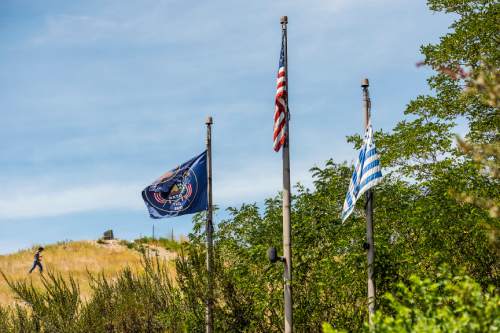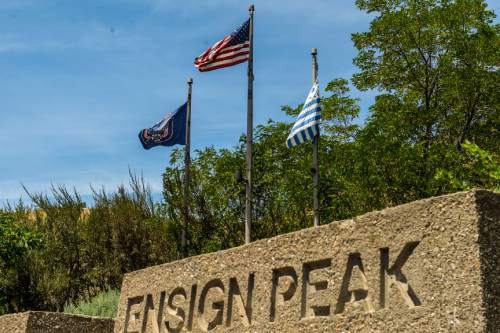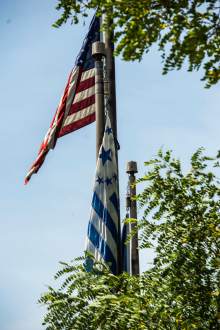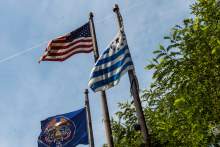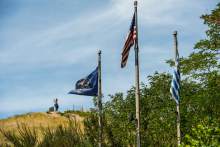This is an archived article that was published on sltrib.com in 2015, and information in the article may be outdated. It is provided only for personal research purposes and may not be reprinted.
The Flag of the Kingdom of God of the State of Deseret flies above Utah's capital city at the Ensign Peak Nature Park — a Salt Lake City municipal park.
After calls to take down the Confederate flag flying over the South Carolina Capitol last week, historian John Gary Maxwell said Utahns should have a similar conversation.
"It's certainly confusing to me," he said regarding the LDS flag. "Up until Brigham Young's death, Utah was a theocracy. There was no separation between church and state."
The Ensign Peak preserve was dedicated to the city by Gordon B. Hinckley, the late president of The Church of Jesus Christ of Latter-day Saints, in 1996. Its trailhead bears three flags: the Stars and Stripes, Utah's state flag and the flag representing the State of Deseret that later became the Territory of Utah before statehood in 1896.
The State of Deseret flag could be at odds with the separation of church and state outlined in the U.S. Constitution, Maxwell said.
And, he noted, even today, Utah legislative leaders meet with LDS officials before the annual legislative session convenes in January.
"It's appropriate for people to discuss what it means," Maxwell said. "With the flag up there, it says to me there is no separation between church and state."
But the historical significance of the saddle of Ensign Peak most likely means that it doesn't violate laws surrounding separation issues, according to Wayne McCormack, professor at the University of Utah's S.J. Quinney College of Law.
"If this is a historic flag of the territory, any religious significance wouldn't make any difference," he said regarding the issue that has been litigated in the U.S. Supreme Court.
Recent high-court rulings, including a Pleasant Grove case involving the Ten Commandments, point to such a conclusion, McCormack added.
"It's pretty clear," he said, "that if it's a historic flag, it's up to the city to decide whether or not they want it."
In fact, there is a well-documented history, according to Utah and LDS historians.
On July 21, 1849, two years after the Mormon pioneers arrived in Salt Lake Valley, Brigham Young and nine others climbed to a peak overlooking their settlement. Young declared that an ensign would be raised there to symbolize the "Kingdom of God," and Mormon sovereignty over the area.
About 147 years later, Hinckley stood on the same ground to dedicate the Ensign Peak Nature Park.
Three flags were raised, including the territorial flag, as the park was presented to the residents of Salt Lake City.
Although the spot has a lot of historical significance to The LDS Church, many people aren't aware of the flag, including City Councilman Stan Penfold, whose District 3 encompasses the trailhead. But according to a spokesman for Mayor Ralph Becker, the territorial flag was included in an agreement between The LDS Church and Salt Lake City at the time of the land transfer.
"The intent at the time [of dedication] was to note the significance of the site to the pioneer founders," said Art Raymond.


